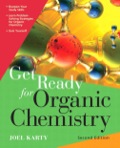
Concept explainers
(a)
Interpretation:
How the given lithium dialkylcuprate reagent can be synthesized from an alkyl, alkenyl, alkynyl, or aryl halide is to be shown.
Concept introduction:
A lithium dialkylcuprate is synthesized from the corresponding alkyllithium reagent by treating it with copper(I) iodide, CuI. Because the metal-bonded C atom bears a partial negative charge on both the alkyllithium reagent and the lithium dialkylcuprate, umpolung technically does not occur in this reaction, but synthesizing a lithium dialkylcuprate from an
(b)
Interpretation:
How the given lithium dialkylcuprate reagent can be synthesized from an alkyl, alkenyl, alkynyl, or aryl halide is to be shown.
Concept introduction:
A lithium dialkylcuprate is synthesized from the corresponding alkyllithium reagent by treating it with copper(I) iodide, CuI. Because the metal-bonded C atom bears a partial negative charge on both the alkyllithium reagent and the lithium dialkylcuprate, umpolung technically does not occur in this reaction, but synthesizing a lithium dialkylcuprate from an alkyl halide does represent polarity reversal at the C atom. The C atom bonded to Cu should be bonded to halide. The carbon atom of C-X bond is electron poor whereas the carbon of C-Cu bond is electron rich.
(c)
Interpretation:
How the given lithium dialkylcuprate reagent can be synthesized from an alkyl, alkenyl, alkynyl, or aryl halide is to be shown.
Concept introduction:
A lithium dialkylcuprate is synthesized from the corresponding alkyllithium reagent by treating it with copper(I) iodide, CuI. Because the metal-bonded C atom bears a partial negative charge on both the alkyllithium reagent and the lithium dialkylcuprate, umpolung technically does not occur in this reaction, but synthesizing a lithium dialkylcuprate from an alkyl halide does represent polarity reversal at the C atom. The C atom bonded to Cu should be bonded to halide. The carbon atom of C-X bond is electron poor whereas the carbon of C-Cu bond is electron rich.
(d)
Interpretation:
How the given lithium dialkylcuprate reagent can be synthesized from an alkyl, alkenyl, alkynyl, or aryl halide is to be shown.
Concept introduction:
A lithium dialkylcuprate is synthesized from the corresponding alkyllithium reagent by treating it with copper(I) iodide, CuI. Because the metal-bonded C atom bears a partial negative charge on both the alkyllithium reagent and the lithium dialkylcuprate, umpolung technically does not occur in this reaction, but synthesizing a lithium dialkylcuprate from an alkyl halide does represent polarity reversal at the C atom. The C atom bonded to Cu should be bonded to halide. The carbon atom of C-X bond is electron poor whereas the carbon of C-Cu bond is electron rich.
Want to see the full answer?
Check out a sample textbook solution
Chapter 19 Solutions
EBK GET READY FOR ORGANIC CHEMISTRY
- Draw the complete, detailed mechanism for the following reaction.arrow_forwardFor each of the following reactions draw the structure of the major organic product in the box provided.Each numbered set of reagents above or below the arrow represents a complete separate reaction.For multi-step reactions give only the structure of the final product.arrow_forwardDraw the complete, detailed mechanism for the following reaction along with the major product. Cl2 HOẠCarrow_forward
- Draw the complete, detailed mechanism for the reaction shown here, and explain why nucleophilic attack takes place predominantly at the epoxide carbon that is attached to the vinyl group. HCI H,0 ОН 63%arrow_forwardPlease drawthe products of the following reactionsarrow_forwardPlease answer completely will give rating surelyarrow_forward
- Draw a mechanism to account for the formation of the NaOH product in the reaction shown here. Hint: Under these A conditions, deprotonation of a propargylic (C=C-CH) carbon is reversible.arrow_forwardGiven the general reaction coordinate diagram for an El reaction, what does the 1st transition state refer to? TS E TS, SM Reaction Coordinate An activated complex between the leaving group and carbocationic species. An activated complex between the nucleophile and carbocationic species. None of these O An activated complex between the base and carbocationic species.arrow_forwardSOLVED PROBLEM: Draw the mechanism that leads to the major product for the following reaction. dinas 010 1. KCN, H,O 2. H₂SO4 ?arrow_forward
- Select one activator & ortho para director to be on a benzene ring to start. You will then add a bromine to this group showing the COMPLETE mechanism, including all resonance structures. Put a box around the stabilizing resonance structure and explain why it is stabilizing.arrow_forward(SYN) Show two different syntheses for the compound shown here, one using (CH3)2CULI as a reagent and the other using (CH3CH2)2CuLi.arrow_forwardDraw reaction of an a,b-unsaturated aldehyde or a ketone with a nucleophile forms a direct addition product and/or a conjugate addition product, depending on the strength of the nucleophile and the structure of the aldehyde or ketone.arrow_forward
 Organic Chemistry: A Guided InquiryChemistryISBN:9780618974122Author:Andrei StraumanisPublisher:Cengage Learning
Organic Chemistry: A Guided InquiryChemistryISBN:9780618974122Author:Andrei StraumanisPublisher:Cengage Learning
